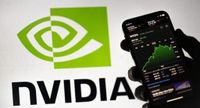In a week dominated by the release of Nvidia's latest earnings, investors and analysts alike found themselves parsing through numbers, projections, and global developments that could reshape the tech landscape. Nvidia, now the world’s most valuable public company with a market cap exceeding $4.4 trillion, reported its fiscal 2026 second-quarter results on August 27, 2025, and the reverberations were felt across Wall Street and beyond.
According to The Motley Fool, Nvidia’s revenue soared 56% year over year to a record $46.7 billion for the quarter ending July 27, 2025, surpassing analyst expectations of $46.05 billion. Net income jumped 59% to $26.4 billion, a staggering figure for a company of any size, let alone one already at the top of the market. Adjusted earnings per share came in at $1.04, outpacing the consensus estimate of $1.01 per share, as reported by TipRanks.
Yet, despite these blockbuster numbers, Nvidia’s stock took a hit. Shares fell more than 3% after hours on August 28 and continued to slide on August 29. The culprit? A slowdown in the company’s all-important data center segment and an outlook for the third quarter that, while robust, didn’t quite meet the sky-high expectations Wall Street had set. Nvidia’s data center revenue, which has become the backbone of its AI business, increased 56% to $41.1 billion—impressive by any measure, but just shy of the $41.3 billion analysts had projected. This marked the second consecutive quarter that data center revenue missed estimates, according to The Motley Fool.
For context, Nvidia’s GPUs are to artificial intelligence what the iPhone is to Apple: the essential engine that powers the company’s core business. These chips are the lifeblood of data centers, enabling companies to train, deploy, and scale AI at unprecedented levels. The market’s reaction, then, was less about disappointment and more about the extraordinary expectations now baked into Nvidia’s valuation. As of August 28, Nvidia’s stock was trading at roughly 41.5 times projected earnings for the next 12 months, compared to a tech sector average of about 30, highlighting both the company’s growth and the risks of such lofty pricing.
Despite the dip, top Wall Street analysts remain bullish. KeyBanc’s John Vinh raised his price target to $230, citing strong fiscal Q3 guidance and the possibility of an additional $2–$5 billion in revenue from China if export licenses are granted. Vinh noted, “Guidance excludes revenue from China, which could add another $2–$5 billion in fiscal Q3 if more licenses are granted.” Mizuho’s Vijay Rakesh echoed this optimism, reiterating an Outperform rating and emphasizing Nvidia’s dominant 95% share of the data center AI chip market. Rakesh projects the market to grow at a 60% compound annual growth rate (CAGR) to over $500 billion by 2028, with Nvidia poised to capture a significant portion.
Truist’s William Stein also raised his price target to $228, focusing on Nvidia’s upcoming Vera-Rubin chip, which is on track for 2026, and management’s suggestion that growth could reach about 50% next year—well above Wall Street’s current forecasts. Stein described the recent sales and guidance as “a minor imperfection” and underscored Nvidia’s status as “the AI company.”
But the story doesn’t end with earnings and projections. Nvidia’s fortunes are closely tied to global geopolitics, particularly the fraught relationship between the U.S. and China. Earlier this year, the Trump administration imposed a ban on H20 chip sales—Nvidia’s China-compliant AI chip—only to reverse it in July after Nvidia agreed to pay a 15% tax on AI-chip revenue generated in China. The deal, however, is not yet finalized, and China has encouraged its companies to avoid buying the chip, leading Nvidia to halt production. According to The Motley Fool, this back-and-forth remains a major overhang for the company’s future prospects in the world’s second-largest economy.
The impact of these developments was felt not just in Nvidia’s stock but across the broader market. On August 29, the S&P 500 closed 0.64% lower at 6,460.26, the Nasdaq Composite fell 1.15% to 21,455.55, and the Dow Jones Industrial Average slipped 0.20% to 45,544.88, as reported by CNBC. Nvidia was among the key laggards, with shares extending their losses by more than 3%. Meanwhile, Alibaba, the Chinese e-commerce giant, reportedly developed a more advanced chip to fill the gap left by Nvidia’s troubles in China, sending its U.S. shares up about 13%.
Inflation data added another wrinkle. The Core PCE, a key inflation measure watched by the Federal Reserve, increased 2.9% in July—the highest since February and a reminder that inflation risks persist. “The Fed opened the door to rate cuts, but the size of that opening is going to depend on whether labor-market weakness continues to look like a bigger risk than rising inflation,” said Ellen Zentner, chief economic strategist for Morgan Stanley Wealth Management, in a statement to CNBC. For now, the odds still favor a September cut, but the focus remains on the jobs market.
Despite the recent pullback, Nvidia’s long-term story remains compelling. The company predicts Q3 revenue will reach $54 billion, a 51% increase from last year. CEO Jensen Huang has outlined a vision in which the world’s largest AI companies—Microsoft, OpenAI, Amazon, Alphabet, Meta Platforms, and others—could spend $3–$4 trillion on AI-related capital expenditures over the next five years, with Nvidia potentially capturing about 70% of that spend. Whether this scenario materializes is anyone’s guess, but the scale of the opportunity is undeniable.
Analysts are nearly unanimous in their optimism. According to TipRanks, Wall Street’s consensus rating on Nvidia is Strong Buy, with 36 Buys, three Holds, and one Sell in the past three months. The average price target of $199.94 per share implies about 10% upside from current levels.
Still, caution is warranted. Nvidia’s premium valuation means any stumble—whether from global politics, competition, or simply failing to meet sky-high expectations—could result in sharp corrections. As The Motley Fool notes, “High valuations leave room for sharp pullbacks if Nvidia doesn’t meet the lofty expectations that seem priced into the stock.” For long-term investors, strategies like dollar-cost averaging may help navigate the inevitable volatility.
In the end, Nvidia’s latest earnings season has underscored both the company’s remarkable achievements and the challenges that come with being the undisputed leader in a rapidly evolving market. As the AI revolution continues to unfold, all eyes will remain on Nvidia—not just for its numbers, but for what they signal about the future of technology itself.




